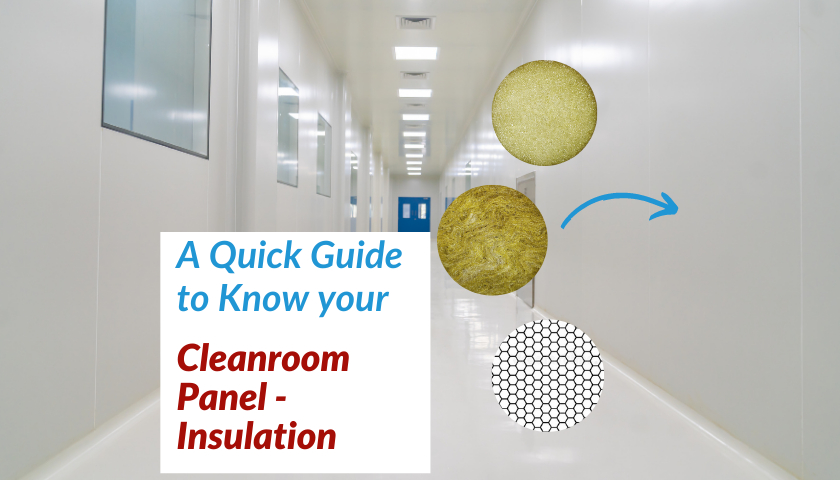A Quick Guide to know your Cleanroom Panel – Insulation

The availability of varied materials for constructing Cleanrooms makes it challenging to understand and make a choice. In the previous article, the emphasis was on outer panels; this blog goes inwards (pun intended).
Insulation (inner filling) plays a vital role in the classification of the panels that differentiate area.
According to the definition as per business dictionary, “Insulation” is a material that retards or prevents the progression or transmission of electricity, heat, moisture, shock, or sound from one item or medium to another. The definition establishes that the primary use of insulation is to avoid heat transfer from the outer unclassified area to an inner classified area.
This insulation is core to HVAC. When designed with the right materials for areas with space restrictions (Modular Panel Cleanrooms) where you need temperature/ humidity control precision with specific air-flow, HVAC ensures prevention of heat loss and results in the efficient and effective use of energy. Thus Cleanroom AHUs can be designed to ensure a particular class is maintained.
Let us understand insulation better as measuring them will help us understand the insulation material. A few essential terms are
- Coefficient of thermal conductivity (K): K-Value denotes the thermal conductivity of a material that helps to measure the ability to conduct heat. When the K-value is lower, the insulation is considered to be better.
- Coefficient of thermal transmittance (U): The release of thermal energy of materials as the transfer rate of heat through matter. So, when the U-value is lower, the insulation is considered to be better.
- Coefficient of thermal resistance (R): This can be denoted by the thermal resistance of insulation against the conductive flow of heat. And the insulation is better as the value of R goes higher.
- Thi can be denoted by the thermal resistance of insulation against the conductive flow of heat. And the insulation is better as the value of R goes higher.
Insulation of Cleanroom Panel depends on its varied usage.
A substantial range of insulation is available, i.e. from light-weighted panels to a fireproof and thermal resistant panels that help to offer an optimal solution that can be tailor-made depending on customer requirements.
- EPS (Expanded Polystyrene): EPS is a lightweight foam-like plastic material made out of beads of polystyrene. It is the most economical and environment-friendly option used for manufacturing Cleanrooms Panels. EPS offers an average density of 20Kg/m3, making this is one of the lightest insulation, low weight panel, easier for installation having a K value of 0.033, R-value of 3.85 per inch. However, a significant disadvantage of EPS even though it provides good insulation, it is not fire-resistant. Hence, it is not ideal for Cleanrooms areas where flammable material will be stored.
- Honeycomb: Thermoplastic Honeycomb Panels are structures that are inspired by nature. This hexagon structure offers essential features in its physical properties such as excellent compressive strength, impact resistance and also lightness, with a density of 60 Kg/m3, and R-value of 3 per inch and K value of 2.37.
- PUF (Poly Urethane Foam): PUF is a stiff foam of a chain of polymer units linked by urethane. It is the most commonly used insulation material in the industry that offers a balance of thermal insulation property as well as low weight and economical option. It has a density of 42 Kg/m3, and K-Value of 0.021, R-Value of 5.6-7 per inch.
- PIR ( Poly Isocyanurate): Due to recent developments in insulation material, there has been an immense interest in PIR as its density is around 30 Kg/m3. Also, its R-Value is 5.6-7 per inch, and K-Value is 0.021, making it a lighter option against PUF. Further, the temperature resistance is beyond 200 C makes it a high-performance insulation material over PUF.
- Rockwool: A mineral-based fibre mass that can be highly resistant to temperature variations, Rockwool has a density of 48 – 160 Kg/m3, and K-Value of 0.035, and R-Value of 3.3 per inch. Hence this is the most desirable option that offers multiple advantages of sound, thermal and fire resistance up to eight hours depending on thickness.
The above information on the different insulation materials highlights the essential aspect of each of the insulation material – its performance. However, insulation should be chosen depending on the purpose and project design of the Cleanroom Modular Panels. For e.g., For storing solvents Rockwool would be ideal as it offers fire resistance and thus the insulation material used for Cleanroom Modular Panels will be Rockwool. Alternatively, a weighing room or an area with sensitive equipment requires sound resistance plays an important role and depending on this criterion, the core insulation material is decided.
The next criteria to follow is the thickness of the modular panel. Here higher the thickness, higher the insulation properties. This means a thicker PUF will offer a similar effect as a thin Rockwool Panel; however, utilisation of space and cost of the project also plays an essential role to choose the ideal material for construction during the designing stage. There is an emphasis on other factors including tensile strength, compressibility, resistance while choosing the insulation material.
In conclusion, successful material selection for insulation is complicated due to an array of options available, and this requires a better understanding of customer requirements and the processes that will be carried out in the Cleanrooms. Also, each country has governed the use of insulation that companies need to be conscious about while designing the panels core material to avoid any legal trouble in future. It is therefore imperative for any company looking to build pharmaceutical capability to involve a formidable partner at the onset of the project, which offers a start-to-finish solution.
Categories
Recent Posts
Subscribe
Never miss a post from Fabtech. Sign up to receive updates direct to your inbox.
